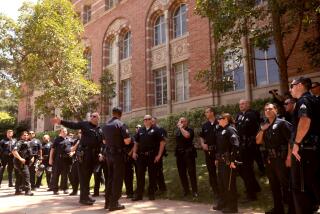Job Transfers Put Schools Chief’s Post in Jeopardy
When she heard that the superintendent had reassigned her principal in March, South Pasadena High School senior Kate Davis was outraged. She and a couple of hundred of her classmates walked out.
Kate’s father, however, supported the move. Lloyd Davis moved from Pasadena so his children could attend the renowned South Pasadena Unified School District. He says the caliber of the high school has deteriorated. And, he believes Principal Janet Anderson is to blame.
For the record:
12:00 a.m. May 28, 2005 For The Record
Los Angeles Times Saturday May 28, 2005 Home Edition Main News Part A Page 2 National Desk 3 inches; 99 words Type of Material: Correction
South Pasadena schools -- In some editions of Monday’s California section, a photograph with an article about a controversy in the South Pasadena Unified School District showed parent Jan McFarlane pointing her finger, and the photo was placed next to a picture of Robert Arias, the district superintendent. The caption should have made clear that McFarlane was not pointing at Arias, but at another member of the audience. Also, the caption portrayed McFarlane as saying Arias should be fired. In clarification, McFarlane said she was commenting on the issue of whether Arias had illegally taped an administrator’s evaluation conference.
For the last two months, the residents of South Pasadena -- no strangers to fighting for their quiet, oak-lined streets and small-town atmosphere -- have sparred over this issue.
As the contentious debate among friends and neighbors -- even fathers and daughters -- escalates, the superintendent’s job hangs in the balance.
South Pasadena “is like this little bubble town that everybody thinks is perfect. But it’s not,” said Kate, who plans to attend the Art Center College of Design in Pasadena in the fall.
Often compared to a Midwestern town -- outside of its $694,000 median home price last year -- South Pasadena is a close-knit community of about 25,000 residents, many of whom moved to the city for its 4,250-student school district.
South Pasadena residents pay two special school taxes, and many also contribute hundreds of dollars each year to the South Pasadena Educational Foundation.
Supt. Rob Arias knew the decision to reassign administrators, made with school board support in a closed meeting in March, would not go unnoticed by South Pasadena parents. But Arias never expected that his own job would be threatened.
“I knew it was politically risky,” he said. “I expected the public outcry, but I didn’t expect them to take it to step Z.”
As a result of Arias’ actions in reassigning the principal, school board member Dr. Richard Sonner introduced a motion April 27 asking the board to consider the “discipline/dismissal/release” of the superintendent. Sonner’s proposal only further divided the town.
Parents and community members held meetings in their homes, allegations of fraud and conspiracy theories surfaced in local newspapers, hundreds of e-mails are being sent to board members and heated discussions are occurring around town and on Internet message boards.
One administrator says that an evaluation conference was illegally taped by the superintendent, a charge that Arias denies. The teachers union has declared war on board members Tammy Godley and Pete Kutzer, both of whom are up for reelection next year, because they supported the superintendent.
“I completely supported him when we hired him. I completely supported him as the year unfolded. As of March 10, I completely supported him,” Sonner said in a telephone interview.
But then everything changed.
In the closed-session meeting March 10, Arias proposed moving Anderson from the high school to an elementary school, along with three other reassignments. Before he approached the board about shifting the administrators, Arias said he was advised by the district’s attorney that he could make lateral administrative moves, but that he needed board approval for a dismissal. By law, all administrative moves needed to be approved and administrators notified by March 15.
The superintendent, who has held the position since July, received full support from each board member on all of the moves, according to four board members and Arias.
But when the administrators were notified that they were going to be reassigned, the letters three of them received from Arias’ office were inaccurate.
All four letters -- instead of just one -- said: “... the Board of Education, in its closed session of March 10, 2005, took action ...” (The board did not take formal action on all of the moves; it took action on one demotion of an assistant principal.)
From there, confusion abounded and accusations flew.
Initially, parents and others believed that the board had voted in closed session about the other three administrators and had failed to inform the public. A Brown Act advocate came to town and filed a complaint giving the board 30 days to rescind the reassignments or face a judge.
High school students staged walkouts either because they didn’t want to see Anderson go, they didn’t like the way she was let go or, as one student said, they just wanted to get out of class.
To compound the matter, Arias and the board discovered that their attorney had been wrong. Under a district regulation adopted in 1997, the board needs to vote to terminate or reassign administrators.
After consulting with board President Joe Loo and legal counsel, Arias approached the administrators and asked them to move into their new assignments voluntarily. The administrators refused.
So on April 27, to avoid legal action, the board rescinded the reassignments and each of the four administrators will remain in their current positions for the 2005-06 school year.
That day, Sonner called for action against the superintendent. “He’s not the right match for our district,” Sonner said last week. “I think a number of mistakes have been made. I don’t see how he can succeed as superintendent.”
The school board and Arias have deliberated about the superintendent’s job for more than four hours in two private sessions over the last two weeks. They are scheduled to meet again Thursday.
Anderson, who has been the high school principal for five years, is a hometown girl who attended South Pasadena High School. She is generally well-liked and was considered an excellent elementary schoolteacher, but many in the community don’t think she is tough enough to improve the high school.
“As an administrator, you know you’re on a year-to-year basis. You don’t have the safeguards you would as a teacher,” Anderson said in an interview last week. “But in a small school district, absent a lot of evidence-based conversation, something like this doesn’t usually happen. We’ve always been people who’ve talked about things.”
Arias, however, said shared decision making has its limits.
“I don’t believe polling the community each time an important decision needs to be made is an effective way to run an organization,” he said. “I don’t believe that’s effective leadership. Eventually somebody needs to make a decision.”
The superintendent and at least three board members characterize the problem with the letters -- which Arias said the district’s legal counsel drew up and he signed -- as a sloppy mistake. The local teachers union leadership, one board member and some parents call it fraud.
“The facts that we’re given don’t add up,” said Mara Coyne, whose son is in the 10th grade. “Is it incompetence? Is it a disregard of the law? Whatever the answer is, I don’t like it.”
Some school board members and Arias say they received a mandate for change, particularly in the middle and high schools, and that the reassignments reflected that. At the high school, they are seeking a tougher administrator who would demand more from teachers and provide more programs for low-achieving students new to the district.
Four of South Pasadena Unified School District’s five campuses each received the highest rankings -- a 10 -- on the state’s 2004 Academic Performance Index, which uses standardized test results in second through 11th grades to measure achievement. The high school earned a 9.
But when compared with other schools in the state with similar demographics, including race, ethnicity, English-language skills and socioeconomic status, the district’s middle school scored a 4 and the high school scored a 3. In 2003, the high school scored a 6.
“Never mind that the school board agreed unanimously that the changes should be made. Never mind that the intentions were good and the substance of the changes made sense,” resident Jennifer Taw said during a four-hour public comment session before a recent closed board meeting.
Taw, who will have one child each in elementary, middle and high school next fall, moved to South Pasadena in 1996 because of its school district.
“People in opposition,” she said, “leaped upon the technicalities and have since let a molehill develop into a mountain, distracting the school board, the district, the superintendent and the community from the more important problems with our schools.”
More to Read
Start your day right
Sign up for Essential California for news, features and recommendations from the L.A. Times and beyond in your inbox six days a week.
You may occasionally receive promotional content from the Los Angeles Times.






